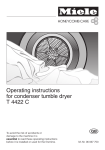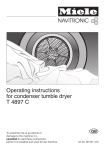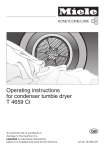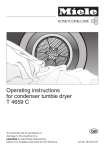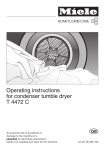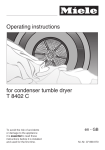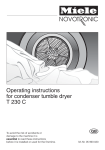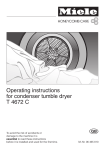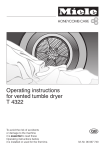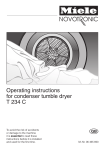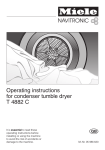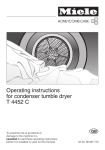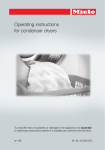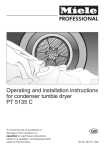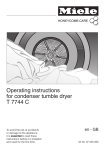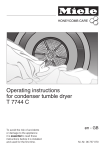Download Miele T 4462 C Operating instructions
Transcript
Operating instructions for condenser tumble dryer T 4462 C To avoid the risk of accidents or damage to the machine it is essential to read these instructions before it is installed and used for the first time. G M.-Nr. 06 465 760 Caring for the environment Disposal of the packing material The transport and protective packing has been selected from materials which are environmentally friendly for disposal and can normally be recycled. Ensure that any plastic wrappings, bags etc. are disposed of safely and kept out of the reach of babies and young children. Danger of suffocation! Rather than just throwing these materials away, please ensure they are offered for recycling. Disposal of your old appliance Electrical and electronic appliances often contain materials which, if handled or disposed of incorrectly, could be potentially hazardous to human health and to the environment. They are, however, essential for the correct functioning of your appliance. Please do not therefore dispose of your appliance with your household waste. It should be unplugged or disconnected from the mains electricity supply by a competent person. The plug must be rendered useless and the cable cut off directly behind it to prevent misuse. See the "Warning and Safety" section of this booklet for further details. Energy saving tips To avoid unnecessarily long drying times and high consumption of energy: – Make sure that your laundry is thoroughly spun before drying. The higher the spin, the greater the savings that can be made in energy and time during drying. – Load according to the optimum amount of laundry recommended for the programme being used (see Programme chart). Underloading is uneconomical. Overloading gives a poorer quality of drying and may cause unnecessary creasing. – Make sure the room in which the dryer is located is well ventilated. – Make sure the fluff filters are clean before using the dryer. – Check the condenser unit from time to time and clean it when necessary. Please dispose of it at your local community waste collection / recycling centre and ensure that it presents no danger to children while being stored for disposal. 2 Contents Caring for the environment . . . . . . . . . . . . . . . . . . . . . . . . . . . . . . . . . . . . . . . . . . 2 Disposal of the packing material . . . . . . . . . . . . . . . . . . . . . . . . . . . . . . . . . . . . . . . 2 Disposal of your old appliance . . . . . . . . . . . . . . . . . . . . . . . . . . . . . . . . . . . . . . . . 2 Energy saving tips . . . . . . . . . . . . . . . . . . . . . . . . . . . . . . . . . . . . . . . . . . . . . . . . . . 2 Warning and Safety instructions . . . . . . . . . . . . . . . . . . . . . . . . . . . . . . . . . . . . . 5 Control panel . . . . . . . . . . . . . . . . . . . . . . . . . . . . . . . . . . . . . . . . . . . . . . . . . . . . . 9 Guide to the appliance . . . . . . . . . . . . . . . . . . . . . . . . . . . . . . . . . . . . . . . . . . . . 10 Notes on laundry care . . . . . . . . . . . . . . . . . . . . . . . . . . . . . . . . . . . . . . . . . . . . . 11 Care symbols . . . . . . . . . . . . . . . . . . . . . . . . . . . . . . . . . . . . . . . . . . . . . . . . . . . . . 11 Tips on drying . . . . . . . . . . . . . . . . . . . . . . . . . . . . . . . . . . . . . . . . . . . . . . . . . . . . 11 How to dry correctly . . . . . . . . . . . . . . . . . . . . . . . . . . . . . . . . . . . . . . . . . . . . . . 12 Brief instructions . . . . . . . . . . . . . . . . . . . . . . . . . . . . . . . . . . . . . . . . . . . . . . . . . . 12 Short . . . . . . . . . . . . . . . . . . . . . . . . . . . . . . . . . . . . . . . . . . . . . . . . . . . . . . . . . 14 Low temperature. . . . . . . . . . . . . . . . . . . . . . . . . . . . . . . . . . . . . . . . . . . . . . . . 14 Buzzer. . . . . . . . . . . . . . . . . . . . . . . . . . . . . . . . . . . . . . . . . . . . . . . . . . . . . . . . 14 Delay start. . . . . . . . . . . . . . . . . . . . . . . . . . . . . . . . . . . . . . . . . . . . . . . . . . . . . . . 16 Programme chart . . . . . . . . . . . . . . . . . . . . . . . . . . . . . . . . . . . . . . . . . . . . . . . . . 17 Changing the programme sequence . . . . . . . . . . . . . . . . . . . . . . . . . . . . . . . . . 19 Electronic system lock . . . . . . . . . . . . . . . . . . . . . . . . . . . . . . . . . . . . . . . . . . . . 20 Cleaning and care . . . . . . . . . . . . . . . . . . . . . . . . . . . . . . . . . . . . . . . . . . . . . . . . 21 Emptying the condensed water container . . . . . . . . . . . . . . . . . . . . . . . . . . . . . . . . . . . . . . . . . . . . . . . . . . . 21 Cleaning the fluff filters . . . . . . . . . . . . . . . . . . . . . . . . . . . . . . . . . . . . . . . . . . . . . 22 Cleaning them whilst dry . . . . . . . . . . . . . . . . . . . . . . . . . . . . . . . . . . . . . . . . . 22 Cleaning them with water . . . . . . . . . . . . . . . . . . . . . . . . . . . . . . . . . . . . . . . . . 23 Cleaning the tumble dryer . . . . . . . . . . . . . . . . . . . . . . . . . . . . . . . . . . . . . . . . . . . 23 Cleaning the condenser unit . . . . . . . . . . . . . . . . . . . . . . . . . . . . . . . . . . . . . . . . . 24 Removing the condenser unit. . . . . . . . . . . . . . . . . . . . . . . . . . . . . . . . . . . . . . 24 Checking the condenser unit . . . . . . . . . . . . . . . . . . . . . . . . . . . . . . . . . . . . . . 25 Cleaning the condenser unit. . . . . . . . . . . . . . . . . . . . . . . . . . . . . . . . . . . . . . . 25 Replacing the condenser unit. . . . . . . . . . . . . . . . . . . . . . . . . . . . . . . . . . . . . . 26 Problem solving guide. . . . . . . . . . . . . . . . . . . . . . . . . . . . . . . . . . . . . . . . . . . . . 27 General problems . . . . . . . . . . . . . . . . . . . . . . . . . . . . . . . . . . . . . . . . . . . . . . . . . 27 Check lights and fault messages . . . . . . . . . . . . . . . . . . . . . . . . . . . . . . . . . . . . . 31 Changing the lamp . . . . . . . . . . . . . . . . . . . . . . . . . . . . . . . . . . . . . . . . . . . . . . . . 33 3 Contents After Sales service. . . . . . . . . . . . . . . . . . . . . . . . . . . . . . . . . . . . . . . . . . . . . . . . 34 Future updates (PC). . . . . . . . . . . . . . . . . . . . . . . . . . . . . . . . . . . . . . . . . . . . . . . . 34 Appliance guarantee . . . . . . . . . . . . . . . . . . . . . . . . . . . . . . . . . . . . . . . . . . . . . . . 34 Optional accessories . . . . . . . . . . . . . . . . . . . . . . . . . . . . . . . . . . . . . . . . . . . . . . . 34 Installation . . . . . . . . . . . . . . . . . . . . . . . . . . . . . . . . . . . . . . . . . . . . . . . . . . . . . . 35 Front view. . . . . . . . . . . . . . . . . . . . . . . . . . . . . . . . . . . . . . . . . . . . . . . . . . . . . . . . 35 Installation site . . . . . . . . . . . . . . . . . . . . . . . . . . . . . . . . . . . . . . . . . . . . . . . . . . . . 36 Transporting the machine to its installation site . . . . . . . . . . . . . . . . . . . . . . . . 36 Building under a continous worktop / in a row of kitchen units . . . . . . . . . . . . 36 Replacing the lid. . . . . . . . . . . . . . . . . . . . . . . . . . . . . . . . . . . . . . . . . . . . . . . . 36 Levelling the machine. . . . . . . . . . . . . . . . . . . . . . . . . . . . . . . . . . . . . . . . . . . . 37 Room in which the dryer is located . . . . . . . . . . . . . . . . . . . . . . . . . . . . . . . . . 37 Washer - dryer stack. . . . . . . . . . . . . . . . . . . . . . . . . . . . . . . . . . . . . . . . . . . . . 37 Before moving the machine again (e.g. when moving house) . . . . . . . . . . . . . 37 External condensed water outlet . . . . . . . . . . . . . . . . . . . . . . . . . . . . . . . . . . . . . . 38 Setting up the drain hose . . . . . . . . . . . . . . . . . . . . . . . . . . . . . . . . . . . . . . . . . 38 Connection to a sink drain outlet . . . . . . . . . . . . . . . . . . . . . . . . . . . . . . . . . . . 39 If you no longer wish to use an external condensed water outlet . . . . . . . . . . 39 Electrical connection . . . . . . . . . . . . . . . . . . . . . . . . . . . . . . . . . . . . . . . . . . . . . 40 Electrical connection U.K. . . . . . . . . . . . . . . . . . . . . . . . . . . . . . . . . . . . . . . . . . . . 40 Consumption data . . . . . . . . . . . . . . . . . . . . . . . . . . . . . . . . . . . . . . . . . . . . . . . . 41 Technical data . . . . . . . . . . . . . . . . . . . . . . . . . . . . . . . . . . . . . . . . . . . . . . . . . . . 42 Programmable functions. . . . . . . . . . . . . . . . . . . . . . . . . . . . . . . . . . . . . . . . . . . 44 Altering the residual moisture level in the Cottons programmes . . . . . . . . . . . . . . 44 Altering the residual moisture level in the Minimum iron programmes . . . . . . . . . 45 Anti-crease. . . . . . . . . . . . . . . . . . . . . . . . . . . . . . . . . . . . . . . . . . . . . . . . . . . . . . . 46 Memory function . . . . . . . . . . . . . . . . . . . . . . . . . . . . . . . . . . . . . . . . . . . . . . . . . . 47 Extending the cooling down time . . . . . . . . . . . . . . . . . . . . . . . . . . . . . . . . . . . . . 48 Clean out airways indicator . . . . . . . . . . . . . . . . . . . . . . . . . . . . . . . . . . . . . . . . . . 49 4 Warning and Safety instructions Technical safety To avoid the risk of accidents and damage to the machine please read these instructions carefully before using it for the first time. They contain important information on its safety, installation, use and maintenance. Keep these instructions in a safe place and ensure that new users are familiar with the content. Pass them on to any future owner of the machine. Correct use The tumble dryer is only intended for drying fabrics which have been washed in a water solution, marked on the manufacturer's care label as being suitable for tumble drying. "Dry cleaning kits" for freshening up garments in a tumble dryer are increasingly available on the market. If using, do so at your own risk, and follow the instructions provided on the packaging. Any other applications may be dangerous. The manufacturer is not liable for damage resulting from improper use or operation. Before setting up the machine, check it for any externally visible damage. Do not install or use a damaged machine. Before connecting the machine, ensure that the connection data on the data plate match the mains electricity supply. If in any doubt, consult a qualified electrician. The electrical safety of this machine can only be guaranteed when continuity is complete between it and an effective earthing system which complies with local and national safety regulations. It is most important that this basic safety requirement is present and regularly tested, and where there is any doubt the household wiring system should be inspected by a qualified electrician. The manufacturer cannot be held liable for the consequences of an inadequate earthing system (e.g. electric shock). Do not connect the machine to the mains electricity supply by an extension lead. Extension leads do not guarantee the required safety of the appliance (e.g. danger of overheating). 5 Warning and Safety instructions The machine is built in accordance with current safety requirements. Unauthorised repairs could result in unforeseen dangers for the user, for which the manufacturer cannot accept liability. Repairs should only be undertaken by a Miele approved technician. Ensure current is not supplied to the machine until after maintenance or repair work has been carried out. Faulty components must only be replaced by genuine Miele original spare parts. Only when these parts are fitted can the safety standards of the machine be guaranteed. If the connection cable is faulty it must only be replaced by a Miele approved service technician to protect the user from danger. In countries where there are areas which may be subject to infestation by cockroaches or other vermin, pay particular attention to keeping the machine and its surroundings in a clean condition at all times. Any damage which may be caused by cockroaches or other vermin will not be covered by the machine guarantee. 6 Warning and Safety instructions In the event of a fault or for cleaning purposes, the machine is only completely isolated from the electiricty supply when: – it is switched off at the wall socket and the plug is withdrawn, or – it is switched off at the mains, or – the mains fuse is withdrawn, or – the screw-out fuse is removed (in countries where this is applicable). Operation This equipment may only be used in mobile installations such as ships, caravans, aircraft etc. if a risk assessment of the installation has been carried out by a suitably qualified engineer. The ambient room temperature should be between +2°C and +35°C. If the water is drained externally through the drain hose instead of being collected in the condensed water container, make sure the drain hose is securely attached if you hang it in a sink or basin to avoid the hose slipping and the water causing damage. Condensed water is not drinking water. It can cause health problems in both people and animals. Always keep the area around the machine free of dust and fluff. Dust drawn into the machine can, over time, cause blockages in the condenser unit. The dryer must not be used without the fluff filters in place or if the fluff filters are damaged in any way. The fluff filters must be thoroughly dried after cleaning. If they are still damp or wet when replaced there is a risk of faults occurring when the machine is used. The dryer must not be used without the condenser unit in place. Do not install the machine in a room where there is a risk of frost occurring. At temperatures around freezing point the machine may not be able to operate properly. There is a risk of damage if the condensed water is allowed to freeze in the pump, hoses and / or condensed water container. 7 Warning and Safety instructions To prevent the risk of fire the following textiles must not be dried in this machine: – fabrics which contain a large proportion of rubber, foam rubber or rubber like materials. – items which contain damaged padding or fillings (e.g. pillows, jackets). – items which have been treated with inflammable cleaning agents. – items which have been splashed with hair lacquer, hair spray, nail varnish remover or similar substances. – items which have been soiled with oils or residues containing grease (kitchen oils, cosmetics etc.). – items soiled with wax or other chemicals (e.g. mops and floor cloths). – items which have not been thoroughly cleaned and which are still soiled with grease or oil, e.g. workwear. Such clothing may require a heavy duty detergent to get them clean. If necessary consult the detergent manufacturer for advice. Do not let anyone sit or lean on the door, as this can cause the machine to tip up. Always close the door after use. This way you will avoid the danger of: – children climbing onto or into the dryer or hiding things in it. – pets or other small animals climbing into it. 8 Safety with children This machine is not a toy. To avoid the risk of injury keep children away from the machine at all times and supervise them whilst you are using it. Do not allow children to play on or near it or to play with its controls. Supervise its use by the elderly or infirm. Using accessories Accessory parts may only be fitted when expressly approved by Miele. If non-Miele parts are used with this machine, guarantee, performance and product liability claims may be invalidated. Disposal of your old machine Before discarding an old machine, switch it off at the wall socket and unplug it. Render the plug useless and cut off the cable directly behind the machine. This should be done by a competent person. The manufacturer cannot be held liable for damage caused by non-compliance with these Warning and Safety instructions. Control panel a Delay Start button The start of a programme can be delayed by up to 24 hours. b Start button Press the Start button to start a programme. The Start indicator light will flash to indicate that a programme can be started. It lights up constantly once the programme has started. c Display d Buttons for selecting and deselecting additional options Indicator light: on = option selected off = option not selected e Cool air / Warm air buttons For selecting the time required for Timed drying with hot or cold air (max. 2 hours). Both the Cool air and Warm air indicator lights will flash when this programme is selected. When one of the buttons is pressed, the appropriate indicator lights will then light up constantly. f Programme selector The programme selector can be turned clockwise or anti-clockwise. g Programme sequence indicator lights Show the drying stage reached. h Check lights See "Problem solving guide" for details. i I-On/0-Off button To switch the appliance on or off or to interrupt a programme. j Door button To open the door / to cancel a programme. Pressing this button will open the door even when the appliance is switched off at the mains. 9 Guide to the appliance Programmes PC / Optical interface – Standard drying programmes for Cotton and Miniumum iron fabrics The indicator light marked PC can used by Miele Service technicians as an optical interface to update your machine in future years. – Automatic, Shirts, Denim, Woollens hand care, Smoothing special programmes – Timed drying programmes Display Electronic system lock – Prevents the machine being used without your knowledge. The following are shown in the display: Programmable functions – the programme duration (time remaining); – For changing the standard settings. – the delay start time; – the programmable functions. Estimated time remaining When a programme is selected the estimated drying time will appear in the display. Please be aware that it is only an estimate! The following factors all affect the estimated time remaining: residual moisture content after spinning; type of fabric; size of load; room temperature; fluctuations in power supply. The electronics continually assess conditions in the machine and adjust the estimated time remaining for a more accurate reading. Because of this the time displayed can alter during the course of a programme. In the same way, the Woollens hand care and Smoothing programmes can finish earlier than expected if a certain temperature is reached. This can happen with particularly fine fabrics or if items were partly dry beforehand. 10 Drum lighting If the dryer is switched on, the drum lighting will come on when the door is opened. It will go out after a short while if the door is left open to save energy. Notes on laundry care Care symbols Before drying check the drying symbol on the care label. If there are no symbols, dry at your own risk! q . . . . . . . . . Dry at normal temperature r. . . . . . . . . . . . Dry at low temperature s . . . . . . . . . . . . . . . Do not tumble dry Tips on drying – Always observe the maximum recommended loads given in the "Programme chart". Never overload the drum. Overloading can cause unnecessary wear and tear to the laundry, give a disappointing drying result and cause more creasing. – Do not put soaking wet items into the tumble dryer. Spin them thoroughly after washing using the appropriate spin speed. – For delicates and fabrics with the following care label r select Low temperature. – Use the Automatic programme for drying mixed loads of cottons and minimum iron fabrics. – Open jackets so that they can dry evenly. – Woollens and wool blends tend to become matted and shrink if dried in a tumble dryer. They can, however, be partially dried using the Woollens handcare programme. – Down-filled garments have linings which have a tendency to shrink, depending on the quality of the item. They can be partially dried using the Smoothing programme. – Pure linen should only be machine dried if specified as suitable by the manufacturer on the care label, as the surface of the fabric may otherwise become rough. They can be partially dried using the Smoothing programme. – Loopknit garments (e.g. T-shirts and underwear) tend to shrink depending on their quality. Do not over-dry these textiles. When purchasing these garments it is advisable to take their shrinkage properties into account. – For garments made from very fine weave fibres, such as shirts or blouses, only use the Shirts or Delicates programme to avoid creasing. If in doubt, reduce the load or use the Smoothing programme. – Starched laundry can be dried in the tumble dryer. To achieve the usual finish, double the amount of starch should be used. – New dark coloured garments should be washed and dried separately from light coloured garments to avoid the danger of colours running and discolouring other garments or even plastic components in the machine. Dark coloured fibres can also settle on light coloured garments and vice versa. 11 How to dry correctly Brief instructions C Load the tumble dryer The headings numbered (A, B, C ...) show the operating sequence and can be used as a brief guide to using your machine. ^ Press the Door button to open the door. ^ Load the laundry loosely into the drum. A Sort the laundry To ensure an even drying result separate out the washed laundry and sort it according to: . . . . . the drying level required . . . the type of fibre or weave . . size . . the moisture content after spinning. ,Make sure that objects e.g. detergent dispensing balls have been removed from the laundry. They could melt, and cause damage to the dryer or the laundry. Do not overload the drum. See the "Programme chart" for recommended loads for each programme. Overloading can cause unnecessary wear and tear to the laundry and give a disappointing drying result. ^ Before closing the door make sure the fluff filter is correctly positioned. – Check seams and stitching to ensure that padding and linings are intact. – Fasten duvet covers and pillow cases to prevent small items from being trapped inside them. – Fasten hooks and eyes etc. – Tie fabric belts and apron strings. – Sew in or remove underwiring from bras. B Turn on the tumble dryer ^ Switch the dryer on by pressing the I-On/0-Off button in. The tumble dryer may be switched on after loading, saving energy as the light will not come on. 12 Check the laundry is right inside the drum so that it cannot get trapped or damaged when the door is shut. ^ Shut the door either with a gentle swing, or lean against it and push it shut. How to dry correctly D Select a programme Timed drying You select the programme duration you require: ^ Turn the programme selector to the required programme. Cottons, Minimum iron, Automatic, Shirts, Denim The duration of the programme selected will depend on the residual moisture of the laundry, fabric type and the load size. This may mean that the duration will be different each time. ^ After selecting the Timed drying programme, press either the Cool air or Warm air button repeatedly until the required time appears in the display. Times of: – I5-30 minutes are selected in steps of 5 minutes – over 30 minutes and up to 2.00 hours in steps of 10 minutes. Woollens hand care and Smoothing The programme duration is fixed for these programmes. 13 How to dry correctly E Select additional option(s) – The programme duration is longer. – On some programmes Low temperature is a standard part of the programme and so cannot be deselected. Buzzer A buzzer sounds (at intervals for a maximum of 1 hr) to let you know the programme has finished. ^ Press the relevant button for the additional option(s) required. – It is not possible to select the Low temperature and Short options at the same time. – See the programme chart for details of the options which are suitable for a particular programme. Short For drying fabrics which can withstand higher temperatures and fabrics with the q symbol on the care label. Do not use on minimum iron or delicate fabrics. – The programme duration is shorter. Low temperature For drying delicates and fabrics with the r symbol on the care label at a lower temperature. – For all delicate or minimum iron fabrics with the r symbol on the care label (e.g. acrylic garments). 14 The buzzer can be switched on or off after a programme has started. The buzzer will still sound if there is a fault, even if it has been deactivated. You can alter the pitch of the buzzer: ^ Select the programme ^ Press the buzzer button (the buzzer indicator light will light up), until the desired pitch is reached. Then release the button. F Select delay start (if required) ^ The start of a programme can be delayed by up to 24 hours (24^). How to dry correctly G Start the programme H Remove the laundry ^ Press the Start button. ^ Press the Door button and open the door. – The indicator light for the Start button will then change from flashing to being on constantly. The drying cycle begins. – Depending on the programme selected, the drying stage reached is shown by the sequence indicator lights on the right hand side of the control panel. Before the end of a programme The cooling down phase takes place before the end of a programme so that the garments are not too hot to handle (the Cool air indicator light will come on). The programme is not finished until the cooling down phase is complete. The Woollens hand care and Smoothing programmes do not include a cooling down phase. At the end of a programme The Anti-crease/Finish indicator light comes on. 0 will then appear in the display. The drum will continue to rotate at intervals to prevent laundry creasing, if you do not wish to remove it immediately (anti-crease). The anti-crease phase lasts for an hour. ^ Remove the laundry. Make sure that the drum is empty. If items are left in the dryer, they could be damaged by overdrying when the dryer is next used. ^ Switch the dryer off by pressing the l-On/0-Off button. ^ Clean the fluff filters in the door and the door opening after each drying programme. ^ Close the door. ^ Empty the condensed water container (where there is no external drainage of the water). ^ The condenser unit should be checked and cleaned on a regular basis. Check lights ... See "Problem solving guide" for details. 15 Delay start To switch on Delay start The start of a programme can be delayed by up to 24 hours (24^). After selecting a programme: While the delay start time is counting down, you can still add laundry to the drum: ^ To do this, first switch the dryer off and open the door. ^ Add the laundry. ^ Close the door and switch the dryer back on again. To cancel Delay start ^ Press the Delay start button repeatedly until the required delay period shows in the display. – The Delay start indicator light will flash. – Times of: up to 10^ are selected in 30 minute steps more than 10^ in 1 hour steps – If you keep the Delay start button pressed in, the time will continue to increase up to 24^. To begin Delay start ^ Press the Start button. – The delay start time will begin to count down and the Delay start indicator light will come on. The delay start time counts down towards the start of the programme as follows: – more than 10^ by the hour – less than 10^ in minutes The drum will turn briefly every hour to help prevent creasing. 16 ^ Press the Delay start button when 24^ is showing in the display. To cancel delay start after you have pressed the Start button: ^ Turn the programme selector to Finish. Programme chart Max. load: 6 kg* Cottons Normal+, Normal** Fabric type Single and multi-layered cotton fabrics such as towelling, jerseywear, underwear, flannelette bed linen. Additional Short, Low temperature (select this option for delicate fabrics with options the r symbol on the care label), Buzzer. Hand iron**, Machine iron Fabric type Cottons or linen fabrics, e.g. table linen, bedlinen, starched laundry. Note – To prevent laundry from drying out it should be rolled up until you are ready for ironing. Additional options Short, Low temperature (select this option for delicate fabrics with the r symbol on the care label), Buzzer. Minimum iron Max. load: 3 kg* Normal+, Normal**, Hand iron Fabric type Minimum iron items made of cotton, synthetic or blended fabrics, e.g. shirts, blouses, skirts and table cloths. Note – Select Hand iron for delicate fabrics and to reduce creasing even more, reduce the load to 1.5 kg*. – In the Miniumum iron Hand iron programme, items are dried with very little creasing, depending on fabric type and amount of load. Additional options Short, Low temperature (select this option for delicate fabrics with the r symbol on the care label), Buzzer. Automatic Max. load: 3 kg* Fabric type Mixed load of cotton and minimum iron fabrics. Additional Buzzer option Shirts Max. load: 2 kg* Fabric type Shirts and blouses Additional Buzzer. Low temperature. (Low temperature cannot be deselected). options * Weight of dry laundry ** Note for test institutes: Use this programme without any additional options when testing according to EN 61121 Standard. 17 Programme chart Denim Max. load: 3 kg* Fabric type Denim fabrics, e.g. jeans, jackets, skirts, shirts. Additional Buzzer. Low temperature. (Low temperature cannot be deselected). options Woollens handcare Max. load: 2 kg* Fabric type Woollen fabrics Note – To refresh and fluff up woollen garments quickly. Woollen fabrics are not dried completely by this programme. – Remove garments as soon as the programme has finished and leave to finish drying at room temperature. Additional Buzzer. Low temperature. (Low temperature cannot be deselected). options Smoothing Max. load: 3 kg* Fabric type – Cottons and linen fabrics. – Minimum iron items made of mixed fibres, cottons or synthetics, e.g. trousers, jackets, shirts. Notes – Smooths out creasing caused during the spin cycle in the washing machine. – Fabrics are not completely dried in this programme. Remove garments as soon as the programme has finished and leave to finish drying at room temperature. Additional Buzzer. Low temperature. (Low temperature cannot be deselected). options Timed drying Max. load: 6 kg* Warm air Fabric type – Multi-layered fabrics whose layers have different drying characteristics, e.g. jackets, pillows. – For drying individual items, e.g. bath towels, bathing costumes, tea-towels. Note Do not select the longest drying time to start with. Check the items as you are drying them to find the optimum time. Additional Low temperature (select this option for delicate fabrics with the r options symbol on the care label), Buzzer. Cool air Fabric type Any item which only needs airing. Additional Buzzer option * Weight of dry laundry 18 Changing the programme sequence Changing a programme while it To interrupt a programme is running ^ Switch the dryer off with the You cannot change to another programme once a programme has started (this prevents unintentional alterations). If the programme selector is turned to a different programme after a programme has begun, this will not affect the programme. The Anti-crease/Finish indicator light will flash. The indicator light will go out when the selector is returned to its original position. You will need to cancel the current programme before you can select a new one. I-On/0-Off button. To continue drying ^ Switch the dryer back on with the l-On/0-Off button. The programme will continue as long as the cooling down phase has not been reached. Adding or removing laundry after a programme has started ^ Press the Door button. ^ Open the door. To cancel a programme ,Do not touch the back of the ^ Turn the programme selector to Finish. drum when adding or removing items. The drum could be very hot danger of burning. To select a new programme ^ Turn the programme selector to the required programme. ^ Select or deselect any additional options required. ^ Add or remove items. ^ Close the door. To continue drying ^ Press the Start button. ^ Press the Start button. Notes The time left shown in the display may now vary from the actual drying time. 19 Electronic system lock The system lock prevents your machine being used without your knowledge. G Switch the machine off with the I-On/0-Off button. To deactivate the lock It can be activated if wished. Before you begin, first ensure that: The dryer's electronics are locked. The dryer can still be switched on but a programme cannot be started. The Locked indicator light will flash if an attempt is made to start a programme. – the door is closed. The door is not locked and can be opened at any time. B Press the Short button and keep it pressed in whilst carrying out steps C to E. To activate the lock C Slowly turn the programme selector clockwise stage by stage to the Cottons Hand iron position. Before you begin, first ensure that: – the door is closed. – The programme selector is at Finish. A Switch the dryer on with the I-On/0-Off button. B Press the Short button and keep it pressed in whilst carrying out steps C to E. C Slowly turn the programme selector clockwise stage by stage to the Cottons Hand iron position. D Slowly turn the programme selector anti-clockwise stage by stage to Finish. E Slowly turn the programme selector anti-clockwise stage by stage to Denim. The Locked indicator light will flash. F Then release the Short button. The system lock is activated. 20 – The programme selector is at Finish. A Switch the dryer on with the I-On/0-Off button. D Slowly turn the programme selector anti-clockwise stage by stage to Finish. E Slowly turn the programme selector anti-clockwise stage by stage to Denim. The Locked indicator light will go out. F Then release the Short button. The system lock is now deactivated. Cleaning and care Emptying the condensed water container The condensed water will be collected in the condensed water container unless the machine has been fitted with a drain hose (see installation). The condensed water container should be emptied after every drying cycle or as soon as the Empty out container indicator lamp comes on. The drying programme will be interrupted if the maximum level of the condensed water container is reached. The Empty out container indicator lamp comes on and the buzzer sounds. ^ Open the shutter and empty out the water. ^ To replace the container hold it at a slight angle (as when removing it) and push it in gently until you feel it click into position. ^ Before starting a new programme, first switch the machine off and then on again. The Empty out container indicator lamp will go out. Condensed water should not be consumed. It could lead to health problems for people and animals. ^ Grip the container firmly with both hands, as shown, and pull it out slightly towards the right-hand side. ^ Hold the container with both hands and carry it in a horizontal position. Condensed water can be put to household use (e.g. used in a steam iron or humidifier). To ensure that any residual particles of fluff in the condensed water are removed before use, pass it through a fine sieve or paper filter first. 21 Cleaning and care Cleaning the fluff filters The fluff which is created by the drying process is collected by the fluff filters in the door and the door opening. Clean the filters after each drying programme. Cleaning them whilst dry Tip: You can also use a vacuum cleaner. ^ Remove any fluff from the hollow part of the door holder. A cleaning brush is available as an optional extra from your Miele dealer or the Miele Spare Parts Department, or use a vacuum cleaner. ^ Once clean, push the filter back into the door holder until it clicks into position. Ensure it is facing the correct way. ^ Also clean the door seal (2) with a damp cloth. ^ Open the door and pull the fluff filter (1) out of the door as illustrated. ^ Use your fingers to remove the fluff from the two fluff filters in the door opening. ^ Close the door. ^ Use your fingers to remove the fluff from the surface of the filter. 22 Cleaning and care Cleaning them with water If there is a great deal of compacted fluff on any of the filters, they can be removed and cleaned under hot running water. ^ To remove the fluff filter from the door holder see previous page. ^ Place the filters back in the door opening (the left and right filters are identical) with the finger holders facing upwards. See illustration. Cleaning the tumble dryer Disconnect the machine from the mains electricity supply. ^ Clean the housing and control panel with a slightly damp cloth and a mild detergent or soapy water. ^ The drum and other stainless steel parts can be cleaned with a suitable proprietary stainless steel cleaner following the manufacturer's instructions. ^ To remove the filters in the door opening, grip the holder and push upwards in the direction of the arrow to remove it. ^ Rinse the filters under hot, running water. ^ Then shake the filters until no more water droplets are visible. ^ Dry the filters thoroughly with care. ,Do not replace them if they are damp or wet. Damp or wet filters could cause operational faults. Do not use solvents, abrasive cleaners, glass cleaners or all-purpose cleaners. These could damage plastic sufaces and other parts. The machine must never be hosed down. ^ Dry all parts with a soft cloth. ^ A microfibre E-Cloth is available from the Miele UK Spare Parts Department which is suitable for cleaning surfaces such as stainless steel, glass, plastic and chrome without the use of chemicals. It can be washed 300 times. ^ Push the large filter back into the door holder until it clicks into position. Ensure it is facing the correct way. 23 Cleaning and care Cleaning the condenser unit Detergent residue, hair and fine fluff from the dryer can get through the fluff filters and block the condenser unit. Dust from the room in which the dryer is installed can also get into the condenser unit and cause a blockage. Check the condenser unit at least twice a year. If the dryer is used frequently then clean the condenser unit after approx. 100 drying cycles. Removing the condenser unit ^ Turn the lever on the inner cover downwards to the vertical position. ^ Pull the cover forwards ^ Then remove it by pulling it diagonally upwards. ^ Open the service panel. The hooks at the side will prevent the panel from falling off. ^ Now remove the panel by pulling it diagonally upwards. ^ Then place it to one side. 24 ^ Turn the lever on the condenser unit to the vertical position. Cleaning and care If you cannot see any fluff: ^ Replace the condenser unit (see following page). If you can see some fluff: ^ Clean the condenser unit as described below. Cleaning the condenser unit ^ When rinsing the condenser unit, make sure you position it as shown in the next two illustrations. ^ Pull the condenser unit out of its housing by the handle. Checking the condenser unit ^ Use a shower head or similar to rinse the unit out as shown. ^ Hold the condenser unit up to the light as shown. ^ Check to see if there is any fluff inside it. The arrows in the illustration above indicate where to look. 25 Cleaning and care Replacing the condenser unit ^ With the handle facing upwards, push the condenser unit back into position in its housing. ^ Turn the lever down to the horizontal position, making sure that the hook on the lever clicks into the groove. When replacing the inner cover after cleaning, ensure that the rubber seal fits correctly into the groove. ^ Then flush the unit through from the front. ^ Check the condenser unit again for any visible fluff and if necessary flush it through again until it has all gone. ^ Remove any soiling still visible inside the housing unit by hand using a damp cloth. Do not try and access areas you cannot reach by hand! ^ Also make sure the rubber seals are clean. The rubber seals must not be removed and must be free of kinks. 26 ^ Replace the inner cover making sure the hooks locate correctly. Hold it at an angle and push it gently downwards. ^ Then turn the lever upwards into the horizontal position to lock the cover. ^ Replace the service panel and press the upper edge until it clicks into position. ,It is important to ensure that both the condenser unit and the cover are correctly positioned and locked otherwise water may leak from the machine. Problem solving guide With the help of the following notes minor faults in the performance of the machine, some of which may result from incorrect operation, can be put right without contacting the Service Department. ,Repair work to electrical appliances should only be carried out by a suitably qualified person in strict accordance with local and national safety regulations. Repairs and other work by unqualified persons could be dangerous. The manufacturer cannot be held liable for unauthorised work. General problems Problem Possible cause The tumble dryer fails to No obvious cause. start when switched on. Items made of synthetic Synthetic fibres tend to fibres are charged with attract static charge. static electricity after drying. Remedy – Have you followed the switch-on procedure correctly (see “How to dry correctly”)? – Is the plug correctly inserted in the socket and switched on? – Is the door closed properly? – Has the fuse or circuit breaker tripped? Static charge can be reduced by adding a fabric conditioner to the final rinse in the washing machine or a fabric conditioner sheet to the load in the dryer. 27 Problem solving guide Problem Possible cause Remedy There is a build up of fluff. Fluff is principally the result of friction when garments are being worn and washed. Machine drying hardly causes any fluff to form and has been established by research institutes to have no appreciable effect on the lifetime of the garment. The load consisted of different fabrics. Fluff is collected by the fluff filters and can be easily removed (see "Cleaning and Care"). The laundry is not sufficiently dry. 28 – Finish drying using "Timed drying - Warm air". – Select a more suitable drying programme next time (see "Programme chart"). Problem solving guide Problem Possible cause Remedy The drying process Important: Before attempting to remedy one of the goes on too long or following causes, switch the dryer off and switch on again even switches off. to start the programme again. Ventilation to and from the Open a door or window while the machine is in dryer may be insufficient (e.g. because it is installed operation for increased air in a small room). This has flow. caused the temperature in the room to rise sharply. The vents below the door – Remove any objects that are blocked. are blocking the vents. The fluff filters are clogged – Remove any fluff. up with fluff or were still wet – The fluff filters must be when they were replaced. completely dry. Detergent residues, hair and Check the condenser unit fine fibres can block up the from time to time and clean condenser unit. it if necessary (see "Cleaning and Care"). The laundry has not been spun sufficiently. Make sure that your laundry is thoroughly spun at the appropriate spin speed. The tumble dryer has been overloaded. Do not exceed the maximum load for the programme selected. – Open zips next time. If the problem occurs again, dry garments with long zips using "Timed drying - Warm air". Metallic components, e.g. zips have prevented the dryer from registering the correct moisture level in the laundry. 29 Problem solving guide Problem Possible cause The inner cover of the condenser unit has not been locked properly and/or the condenser unit has not been positioned correctly. Water leaks from the Fluff has collected at the machine after the bottom of the condenser condenser unit has unit housing. been cleaned. The lighting switched off The interior drum lighting does not automatically. come on. The condenser unit service panel will not shut. Remedy – Ensure that the condenser unit is positioned correctly and lock the cover. – Check the rubber seals. – Use a cloth to remove any fluff from the inside of the condenser unit housing. The lighting only comes on when the door is opened if the dryer is switched on. To save energy the lighting goes out after a while if the door is left open. The lamp needs changing. Change the lamp as described at the end of this section. The ring around the It lights up when drying is – The ring will light up again programme selector in progress and goes out if you press any of the buttons. does not light up. shortly after the end of the programme to save energy. 30 Problem solving guide Check lights and fault messages Problem The Clean out airways light comes on. Possible cause Remedy This indicator light comes on to warn you that the dryer is not working efficiently. The fluff filters may be Remove any fluff (see blocked. "Cleaning and care"). Detergent residues, hair and Check the condenser unit fine fibres can block up the from time to time and clean it condenser unit. if necessary (see "Cleaning and Care"). – The indicator light will go out when you open the door, if the dryer is switched on. – The Clean out airways indicator light can be deactivated (see "Programmable functions"). The programme See above for possible causes and their remedies. stops and the No obvious cause. – Switch the dryer off and Clean out then on again. airways indicator – Then start the programme light is flashing. again. The Empty out container indicator light comes on. The condensed water container is full or there is kink in the drain hose. If the programme stops again and the fault message reappears there is a fault. Contact the Miele Service Department. – Empty out the condensed water container. – Check the drain hose. – The indicator light will go out if you switch the dryer off and then back on again. 31 Problem solving guide Problem Possible cause Remedy The Anti-crease/Finish indicator light flashes while drying is in progress. The programme selector was moved after the start of a programme. The programme continues to run as normal. No obvious cause. Turn the selector back to the original position and the indicator light will go out. The programme stops and the Machine iron or Hand iron indicator light flashes. The buzzer sounds. The programme stops and the Anti-crease/Finish indicator light comes on. 0 will appear in the display. The buzzer sounds. The time remaining pauses. Bars =...-... appear in the display. The Locked indicator starts flashing after the dryer has been switched on. A programme cannot be started. 32 This is not a fault. The electronic unit has recognised that there is no laundry in the drum and cancelled the programme. Drying individual garments or items which are already dry can also cause the programme to be cancelled. This is not a fault. The drying process is not yet complete. The system lock is activated. – Switch the dryer off and then on again. – Then start the programme again. If the programme stops again and the indicator light flashes again there is a fault. Contact the Miele Service Department. – Use the Timed drying Warm air programme to dry individual items. – The indicator light will go out when you open and close the door, if the dryer is switched on. The programme has taken longer than was estimated at the beginning. The adjusted time remaining will appear in the display after a while. You will need to deactivate the system lock before the dryer can be used (see "Electronic system lock"). Problem solving guide Changing the lamp Disconnect the machine from the mains electricity supply. The lamp specification and maximum wattage is stated on the data plate and on the lamp cover. ^ Open the door. ^ Replace the lamp. You will find the interior lamp cover at the top of the drum aperture. ^ To close the cover push it upwards and press it on the left and right until you hear it click into position. ,Ensure that it is fitted into position securely, as any moisture could cause a short circuit. ^ Insert a suitable tool, such as a wide bladed screwdriver, under the side edge of the lamp cover as illustrated. ^ Apply a little pressure and whilst doing so turn your wrist in the direction of the arrow to open the cover. The cover will open downwards. The temperature resistant lamp should only be ordered from your Miele dealer or the Miele Spare Parts Department. 33 After Sales service In the event of any faults which you cannot remedy yourself, or if the machine is under guarantee, please contact – your Miele dealer or – the Miele Service Department (see back cover for contact details). When contacting your dealer or the Service Department, please quote the model and serial number of your machine, both of which are shown on the data plate situated on the right hand side below the drum aperture. Future updates (PC) The indicator or check light marked PC on the fascia panel is the interface used by the Miele service technicians during service work for testing purposes and for updating the machine's programme data. Appliance guarantee Please see the guarantee card supplied with your machine. Optional accessories Optional accessories for this dryer are available from your Miele Dealer or from the Miele Spare Parts Department. Please note that telephone calls may be monitored and recorded for training purposes. 34 Installation Front view a Mains connection cable e Service panel for condenser unit b Condensed water container f Four height-adjustable screw feet c Control panel g External drainage options (e.g. via wash basin, wash basin drain outlet, or gully). d Door 35 Installation Installation site ,Make sure the dryer door can be opened without hindrance after installation. Transporting the machine to its installation site When moving the machine you can hold it by the lid where it protrudes to the rear of the dryer. To manoeuvre the dryer out of its packing case to its installation site you will also need to hold it by the front feet. Building under a continous worktop / in a row of kitchen units The dryer should not be installed next to a refrigerator or freezer. The warm air expelled from the rear of the dryer would increase the temperature around the refrigerator's/freezer's heat exchanger causing the compressor to run continuously. If it is not possible to install the dryer anywhere else, then the refrigerator/freezer must be sealed off from the dryer. If you wish to push your machine under a worktop and there is space to do this without removing the lid, a building under kit is not necessary. Otherwise the building under kit is essential. ,The building under kit* must be fitted by a suitably qualified person. The machine lid is replaced by a coverplate. It is essential that the coverplate is fitted to ensure electrical safety. The building under kit is supplied with its own installation instructions. N.B. When built under running times may be longer. – The electrical socket must be located in an accessible position near the machine. With niche heights of: – 840 mm, longer screw feet* are required. – 870/885 mm - 915/930 mm, one or two height adjustment frames* are required. * Available as an optional accessory from your Miele dealer or the Miele Spare Parts Department. Replacing the lid If the lid has been removed in order to fit a cover plate, ensure that, if the lid is replaced, it fits securely into the rear holders. Otherwise, it is not properly secure for transport. 36 Installation Levelling the machine Room in which the dryer is located Air taken in for use in the drying process will be warm when it is expelled from the rear of the dryer. This expelled air heats up the air in the room. It is therefore very important to ensure that the room is adequately ventilated, particularly if the dryer is located in a small room. Otherwise running times and energy consumption could be increased. Washer - dryer stack The machine must be perfectly level to ensure safe and proper operation. The tumble dryer can also be combined with a Miele washing machine in a washer-dryer stack. To do this the appropriate stacking kit* (WTV) to match your washing machine is required. * Available as an optional accessory from your Miele dealer or the Miele Spare Parts Department. ,Stacking kits must be fitted by a suitably qualified fitter. Before moving the machine again (e.g. when moving house) ^ The screw feet can be adjusted to compensate for any unevenness in the floor. ,The ventilation gaps in the plinth must not be covered over as this would prevent a sufficient intake of air. After each use a small quantity of condensed water will collect in the area around the pump. This water can run out if the machine is tipped up when it is being moved. It is a good idea to run the Cool air programme for approximately 1 minute before moving the machine. Any remaining condensed water will then be fed into the condensed water container or out through the drain hose. 37 Installation External condensed water outlet From the back of the dryer at the bottom: When drying is in progress, condensed water is pumped into the condensed water container through the drain hose at the back of the dryer. The condensed water can also be drained off directly if the machine is installed near a sink, drain outlet etc. so that the condensed water container does not have to be emptied. The drain hose (approx. 2 m long) is stored in the dryer. It must be pulled out of the dryer to its full extent if condensed water is to be drained externally. Maximum delivery head: 1.50 m. If it is not long enough, an extension hose is available as an optional accessory through your dealer or from the Miele Spare Parts Dept. Setting up the drain hose ^ Unclip the drain hose from clip (3). ^ Then pull the drain hose completely out of the dryer towards the left (4) (See illustration). Important: ,Do not let the drain hose become kinked, as this could damage it. From the back of the dryer at the top: ,If you want to drain the water off into a sink you will need to secure the hose carefully, e.g. by tying it to a tap to make sure it cannot slip during use. Otherwise there is a risk of overflowing water which could cause damage. Use the bow-shaped guide to prevent the drain hose from becoming kinked (see "Front view" illustration). ^ Unclip the drain hose from clip (1). ^ Then pull it off holder (2). 38 Installation Connection to a sink drain outlet The drain hose can be connected directly to a sink drain outlet. If this nut has a flat disc in it you should take the disc out first. Important: if this nut has a washer or seal in it this must not be removed! ^ Attach the end of the hose to adapter 1. ^ Use a screwdriver to tighten hose clip 3 up close to the nut. If you no longer wish to use an external condensed water outlet ,Do not push the drain hose back into the dryer. Doing this could cause it to become kinked and damaged in the dryer. ^ Remove the following from the back of the dryer at the bottom: Adapter 1 and hose clip 3 behind it. ^ Loop the drain hose up. ^ Use a suitable cable tie to secure the looped hose to the back of the dryer, or simply lay the looped hose behind the dryer. ^ Attach the open end of the drain hose back onto the holder at the back of the dryer at the top (see holder 2 in "Setting up the drain hose"). ^ Fit adapter 1 to the sink drain outlet using nut 2. 39 Electrical connection Electrical connection U.K. Non-rewireable plugs BS 1363 All electrical work should be carried out by a suitably qualified and competent person, in strict accordance with current national and local safety regulations (BS 7671 in the UK). The fuse cover must be refitted when changing the fuse, and if the fuse cover is lost, the plug must not be used until a suitable replacement is obtained. The colour of the correct replacement cover is that of the coloured insert in the base of the plug, or the colour that is embossed in words on the base of the plug (as applicable to the design of plug fitted). Ensure power is not supplied to the appliance until after installation work has been carried out. The appliance is supplied with a mains cable with moulded plug ready for connection to a 230-240V mains supply. Please ensure the connection data quoted on the data plate match the household mains supply. Connection should be made via a suitable switched socket which is easily accessible after installation. For extra safety it is advisable to install a residual current device (RCD), with a trip current of 30 mA (in accordance with DIN VDE 0664, VDE 0100 Section 739). Do not connect via an extension lead. Extension leads do not guarantee the required safety of the appliance (e.g. danger of overheating). 40 Replacement fuses should be ASTA approved to BS 1362 and have the correct rating. Replacement fuses and fuse covers may be purchased from your local electrical supplier. WARNING: THIS APPLIANCE MUST BE EARTHED Consumption data Programme Load Final spin speed in a domestic washing machine Energy Time kg* rpm kWh Minutes Cottons Normal 6.0 800 (70 % residual moisture)** 1200 1400 1600 1800 3.90 3.10 2.90 2.80 2.55 109 87 83 81 74 Cottons Hand iron 6.0 800 (70 % residual moisture)** 1200 1400 1600 1800 3.25 2.40 2.25 2.15 1,85 93 71 66 64 56 Minimum iron Normal 3.0 1000 (50 % residual moisture)** 1.50 47 Minimum iron Hand iron 3.0 1000 1.30 41 Automatic 3.0 900 1.85 66 Shirts 2.0 900 1,25 48 Denim 3.0 800 1,75 52 Woollens hand care 2.0 900 0.15 4 Smoothing 3.0 - 0.30 8 * Weight of dry laundry ** EN 61121 test programme All data established in accordance with EN 61121. Before testing in accordance with EN 61121, dry a 3 kg load of cotton laundry with 70% residual moisture as per the above standard using the Cottons Normal programme without any additional options. Consumption data can vary from the nominal values given above depending on the size of the load, types of textiles, residual moisture levels after spinning, fluctuations in the electricity supply and any additional options selected. 41 Technical data Height 850 mm (adjustable +7 / -7 mm) Height for building under 820 mm Width Depth 595 mm 580 mm Depth with door open Weight 1,060 mm 54 kg Drum volume Maximum capacity 100 litres 6 kg dry weight Capacity of condensed water container Hose length approx. 3.5 l 2m Maximum delivery head Maximum drain hose length 1.50 m 4m Length of connection cable Voltage 2m see data plate Connected load Fuse rating (UK) see data plate see plug Lamp wattage Energy consumption see data plate see "Consumption data" section Test certificates awarded Radio / TV suppression, VDE 42 Programmable functions for changing default settings The programmable functions are used to alter the machine's electronics to suit changing requirements. Programmable functions can be altered at any time. 43 Programmable functions Altering the residual moisture level in the Cottons programmes The machine is designed to dry effectively using as little energy as possible. However, if you require the laundry to be drier, it is possible to reduce the default residual moisture level in the Cottons programmes. Please note that programme durations will be longer if this option is activated. Follow steps A to F to programme and store in memory. Before you begin, first ensure that: – The tumble dryer is switched off. – The door is closed. – The programme selector is at Finish. A Press the Start button and keep it pressed in whilst carrying out steps B-C. B Press the I-On/0-Off button in. As soon as the indicator light for the Start button lights up constantly . . . C . . . release the Start button. D Turn the programme selector to the Cottons Normal position. P... 0 will appear alternately in the display to show that a setting is selected. The number which appears alternately in the display with P means: 0 Default residual moisture setting I Drier setting (the Drying indicator light will also flash) E Pressing the Start button switches from one number to the other. F Switch the machine off with the I-On/0-Off button. The setting you have selected is now stored in memory. You can change it again at any time. 44 Programmable functions Altering the residual moisture level in the Minimum iron programmes The machine is designed to dry effectively using as little energy as possible. However, if you require the laundry to be drier, it is possible to reduce the default residual moisture level in the Minimum iron programmes. Please note that programme durations will be longer if this option is activated. Follow steps A to F to programme and store in memory. Before you begin, first ensure that: – The tumble dryer is switched off. – The door is closed. – The programme selector is at Finish. A Press the Start button and keep it pressed in whilst carrying out steps B-C. B Press the I-On/0-Off button in. As soon as the indicator light for the Start button lights up constantly . . . C . . . release the Start button. D Turn the programme selector to the Cottons Hand iron position. P... 0 will appear alternately in the display to show that a setting is selected. The number which appears alternately in the display with P means: 0 Default residual moisture setting I Drier setting (the Drying indicator light will also flash) E Pressing the Start button switches from one number to the other. F Switch the machine off with the I-On/0-Off button. The setting you have selected is now stored in memory. You can change it again at any time. 45 Programmable functions Anti-crease If laundry is not removed as soon as the programme has finished, the drum will continue to rotate at intervals for one hour to prevent creasing. A Press the Start button and keep it pressed in whilst carrying out steps B-C. B Press the I-On/0-Off button in. As soon as the indicator light for the Start button lights up constantly . . . The anti-crease function C . . . release the Start button. – is activated when the machine is delivered. You can deactivate it if wished. D Turn the programme selector to the Cottons Machine iron position. – is present on all programmes except Woollens hand care. – should be left activated, if laundry is not normally removed immediately after the end of a programme. P... i will appear alternately in the display to show that a setting is selected. The number which appears alternately in the display with P means: Follow steps A to F to programme and store in memory. I Anti-crease activated (the Drying indicator light will also flash) Before you begin, first ensure that: 0 Anti-crease deactivated – The tumble dryer is switched off. E Pressing the Start button switches from one number to the other. – The door is closed. – The programme selector is at Finish. F Switch the machine off with the I-On/0-Off button. The setting you have selected is now stored in memory. You can change it again at any time. 46 Programmable functions Memory function If an additional option has been selected for a programme or a duration has been selected for a timed drying programme, the machine will store this information in memory. When this programme is chosen again, these settings will also be selected. You can accept these or change them by pressing a button. The dryer is delivered with the Memory function deactivated. You can activate it if wished. Follow steps A to F to programme and store in memory. Before you begin, first ensure that: – The tumble dryer is switched off. – The door is closed. – The programme selector is at Finish. A Press the Start button and keep it pressed in whilst carrying out steps B-C. B Press the I-On/0-Off button in. As soon as the indicator light for the Start button lights up constantly . . . C . . . release the Start button. D Turn the programme selector to the Minimum iron Normal position. P... 0 will appear alternately in the display to show that a setting is selected. The number which appears alternately in the display with P means: 0 Memory activated I Memory deactivated (the Drying indicator light will also flash) E Pressing the Start button switches from one number to the other. F Switch the machine off with the I-On/0-Off button. The setting you have selected is now stored in memory. You can change it again at any time. 47 Programmable functions Extending the cooling down time The cooling down phase which takes place before the end of a programme can be lengthened if required. This makes the garments easier to handle. The dryer is delivered with the extended cooling down time option deactivated. You can extend the cooling down time by 5 minutes or 10 minutes. The option of extending the cooling down time is available with the Cottons and Minimum iron programmes. Follow steps A to F to programme and store in memory. Before you begin, first ensure that: – The tumble dryer is switched off. – The door is closed. – The programme selector is at Finish. A Press the Start button and keep it pressed in whilst carrying out steps B-C. B Press the I-On/0-Off button in. As soon as the indicator light for the Start button lights up constantly . . . C . . . release the Start button. D Turn the programme selector to the Minimum iron Hand iron position. P... 0 will appear alternately in the display to show that a setting is selected. The number which appears alternately in the display with P means: 0 The cooling down time is not extended. I The cooling down time will be five minutes longer. (The Drying indicator light will also flash). I The cooling down time will be ten minutes longer. (The Drying indicator light will also flash). E Pressing the Start button switches from one number to the other. F Switch the machine off with the I-On/0-Off button. The setting you have selected is now stored in memory. You can change it again at any time. 48 Programmable functions Clean out airways indicator The Clean out airways indicator light can be deactivated. The Clean out airways indicator light – is activated when the machine is delivered. The light is a reminder to clean the fluff filters and to check and clean the condenser unit, if necessary. See "Problem solving guide". – should only be deactivated if you are certain that the fluff filters will be cleaned after every drying programme and that the condenser unit will be checked and cleaned regularly. Follow steps A to F to programme and store in memory. Before you begin, first ensure that: – The tumble dryer is switched off. – The door is closed. – The programme selector is at Finish. A Press the Start button and keep it pressed in whilst carrying out steps B-C. B Press the I-On/0-Off button in. As soon as the indicator light for the Start button lights up constantly . . . C . . . release the Start button. D Turn the programme selector to the Woollens hand care position. P... i will appear alternately in the display to show that a setting is selected. The number which appears alternately in the display with P means: I the Clean out airways indicator light is activated (the Drying indicator light will also flash) 0 the Clean out airways is deactivated E Pressing the Start button switches from one number to the other. F Switch the machine off with the I-On/0-Off button. The setting you have selected is now stored in memory. You can change it again at any time. 49 50 51 Alteration rights reserved/0806 M.-Nr. 06 465 760 / 01 en - GB




















































